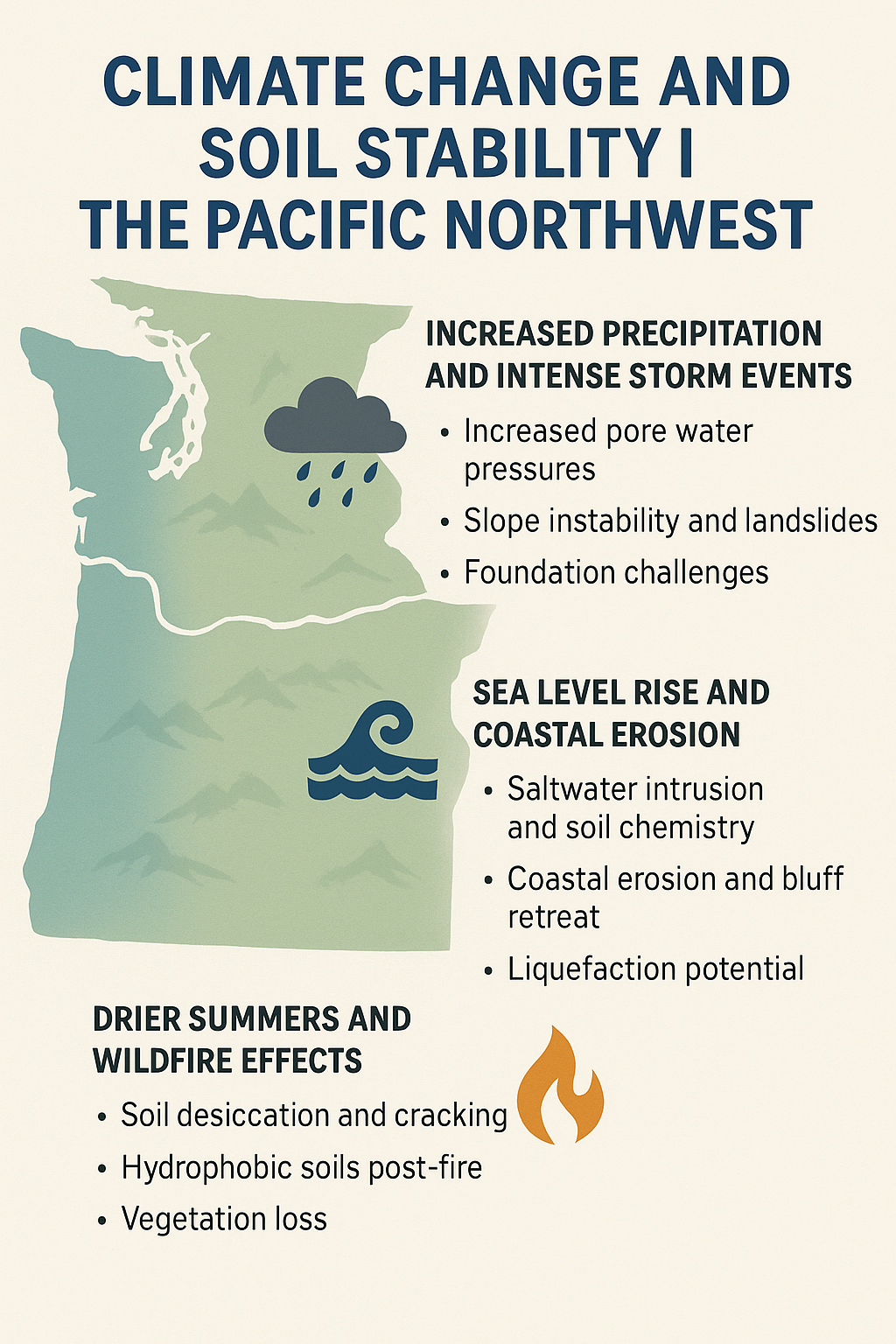Climate Change and Soil Stability in the Pacific Northwest
Introduction
Climate change is no longer a distant concern—its effects are being felt now, and geotechnical engineers are on the front lines of addressing its implications. In the Pacific Northwest (PNW), a region known for its diverse terrain and variable climate, shifts in precipitation patterns, rising sea levels, and changing temperature regimes are beginning to alter soil behavior in significant ways. Understanding and adapting to these changes is essential for maintaining infrastructure safety and resilience.
1. Increased Precipitation and Intense Storm Events
One of the most immediate consequences of climate change in the PNW is the shift toward wetter winters with more frequent and intense storm events. According to the Climate Impacts Group at the University of Washington, the region is experiencing heavier rainfall over shorter durations, especially in the winter months.
Geotechnical Impacts:
Increased pore water pressures: Heavy rainfall can raise groundwater levels and increase pore water pressures, reducing effective stress and shear strength in soils. This makes slopes more susceptible to failure.
Slope instability and landslides: The PNW’s hilly and mountainous regions, particularly in western Washington and Oregon, are prone to landslides during and after heavy rain events. Clay-rich and volcanic soils in areas like the Puget Sound Lowlands are particularly vulnerable.
Foundation challenges: Flooding and saturated ground conditions can reduce bearing capacity and increase the risk of settlement for shallow foundations.
Engineering Considerations:
Incorporate climate-adjusted rainfall intensities in slope stability and drainage design.
Utilize robust dewatering and subsurface drainage systems for critical infrastructure.
Monitor high-risk slopes with geotechnical instrumentation for early warning of movement.
2. Sea Level Rise and Coastal Erosion
Global sea levels are rising, and the PNW is experiencing a complex pattern of relative sea level changes due to tectonic uplift and subsidence. Low-lying coastal areas like those near Grays Harbor, the Columbia River Estuary, and Puget Sound are at increasing risk.
Geotechnical Impacts:
Saltwater intrusion and soil chemistry: As seawater encroaches into coastal aquifers and floodplains, it can alter the geochemistry of soils, potentially affecting the behavior of expansive clays and corrosivity to foundations.
Coastal erosion and bluff retreat: Rising seas and stronger wave action accelerate the erosion of coastal bluffs, threatening infrastructure and reducing slope stability.
Liquefaction potential: Increased saturation in coastal soils can exacerbate liquefaction hazards during seismic events—a significant concern in this seismically active region.
Engineering Considerations:
Employ erosion control measures such as retaining structures, geotextiles, and revegetation.
Perform regular geotechnical assessments of coastal sites and update hazard maps.
Design foundations to account for potential scour and increased lateral loads.
3. Drier Summers and Wildfire Effects
While winters are getting wetter, the PNW is also experiencing hotter and drier summers. This seasonal imbalance increases the risk of wildfires, particularly in eastern Washington and Oregon.
Geotechnical Impacts:
Soil desiccation and cracking: Extended dry periods can cause shrinkage in clayey soils, leading to fissures that reduce soil strength and affect pavement and foundation performance.
Hydrophobic soils post-fire: Wildfires can create water-repellent soil layers, leading to reduced infiltration and increased surface runoff—raising the risk of erosion and debris flows during subsequent rains.
Vegetation loss: The removal of stabilizing vegetation due to fire increases slope vulnerability to mass wasting events.
Engineering Considerations:
Plan for post-wildfire assessments in high-risk zones and implement emergency slope stabilization.
Consider seasonal moisture variation in long-term foundation and pavement designs.
Use bioengineering techniques to re-establish vegetation and reduce erosion.
Conclusion: Engineering for a Changing Climate
The Pacific Northwest’s unique topography and climatic diversity make it particularly sensitive to climate-induced geotechnical hazards. Geotechnical engineers must integrate climate projections into their site investigations, designs, and monitoring strategies to ensure the long-term stability of infrastructure.
By recognizing the evolving nature of precipitation, sea level, and temperature patterns—and understanding their impact on soil behavior—engineers can design resilient systems that safeguard communities and ecosystems across the region.
Call to Action:
At Strata Design, we’re committed to helping clients navigate these emerging challenges through innovative geotechnical solutions and climate-informed design. Contact us today to learn how we can support your next project in a changing world.

